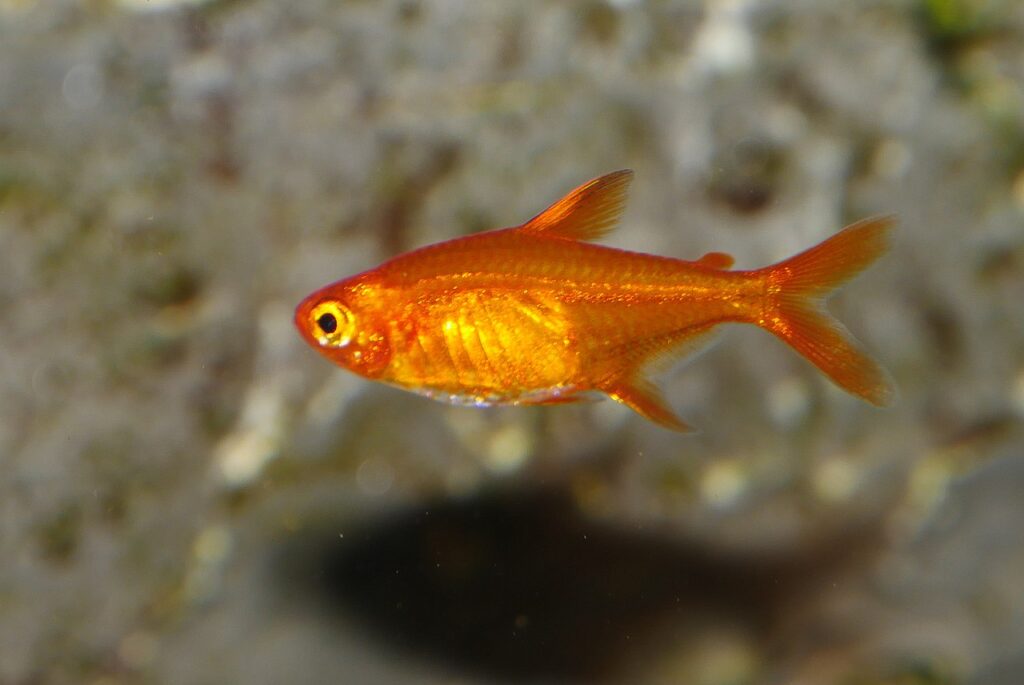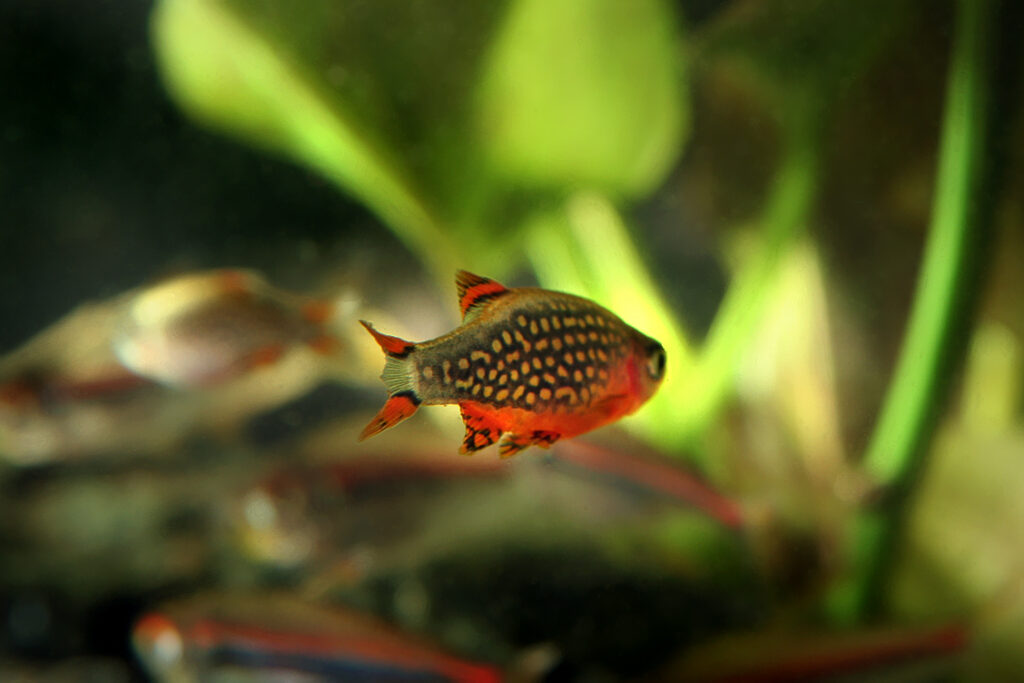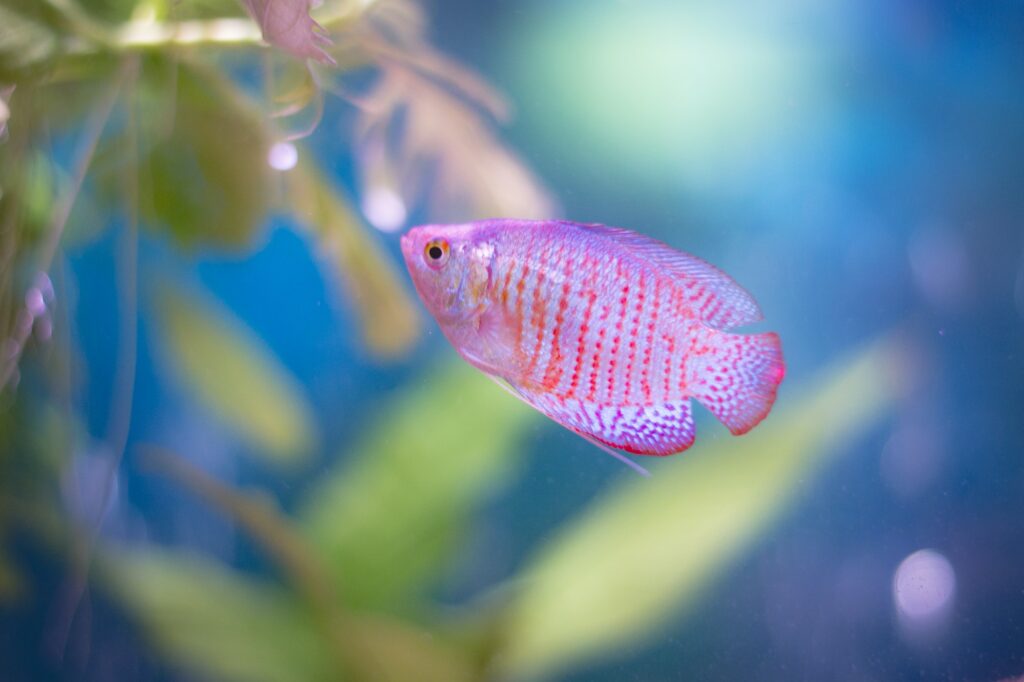Deep in the heart of the Amazon basin, a tiny fish with a big personality swims through the murky waters. The Panda Dwarf Cichlid, scientifically known as Apistogramma nijsseni, is a fascinating creature that has captured the hearts of aquarium enthusiasts worldwide. This small but mighty fish belongs to the Cichlidae family, which is known for its diverse and colorful species.
Table of Contents
One of the most interesting aspects of the Panda Dwarf Cichlid is its unique appearance. The fish features a striking black and white pattern that resembles the iconic markings of a panda bear, hence its common name. This distinctive coloration makes it stand out among other dwarf cichlids and adds to its allure as an aquarium inhabitant.
The Panda Dwarf Cichlid is a bottom-dwelling species that prefers a habitat with plenty of hiding spots and vegetation. In the wild, these fish can be found in the slow-moving tributaries and streams of the Amazon River system. They thrive in water with a pH range of 5.5 to 7.0 and a temperature between 72 and 79 degrees Fahrenheit.
When it comes to tank mates, the Panda Dwarf Cichlid is a relatively peaceful species that can coexist with other small, non-aggressive fish. However, it is important to note that males can become territorial during breeding season and may display aggressive behavior towards other males of the same species. It is recommended to keep only one male per tank or provide ample space and hiding places to minimize conflicts.
In terms of diet, the Panda Dwarf Cichlid is an omnivore that feeds on a variety of small invertebrates and plant matter in the wild. In captivity, they readily accept high-quality flake food, pellets, and frozen or live foods such as brine shrimp and bloodworms. Providing a balanced diet is crucial for maintaining their health and vibrant coloration.
Despite its small size, typically reaching only 2 to 2.5 inches in length, the Panda Dwarf Cichlid has a big personality. They are known for their curious and engaging behavior, often interacting with their tank mates and exploring their surroundings. This active and entertaining nature makes them a popular choice among aquarium hobbyists.
Throughout history, the Panda Dwarf Cichlid has been known by various names in the aquarium trade. Some common alternative names include Nijssen’s Dwarf Cichlid, Panda Apisto, and Panduro. These names often reference the fish’s unique appearance or pay homage to the Dutch ichthyologist Han Nijssen, who first described the species in 1979.
While the Panda Dwarf Cichlid is a relatively new addition to the aquarium scene compared to some other popular species, it has quickly gained a dedicated following among cichlid enthusiasts. Its striking appearance, engaging personality, and manageable size make it an attractive choice for both beginner and experienced aquarists alike.
Fun fact: Did you know that the Panda Dwarf Cichlid is a cave-spawning species? During breeding season, the female will lay her eggs in a small cave or crevice, where the male will then fertilize them. The female will then guard the eggs and fry until they are old enough to fend for themselves.

Panda Dwarf Cichlid Key Information
The Panda Dwarf Cichlid (Apistogramma nijsseni) is a stunning freshwater fish that captivates aquarium enthusiasts with its unique and striking coloration. This small cichlid features a white body adorned with bold, black vertical stripes, resembling the iconic markings of a panda bear. The contrasting black and white pattern is further accentuated by the presence of a vibrant blue hue on the fins, particularly the dorsal and anal fins, adding an extra touch of brilliance to this already eye-catching fish.
| Family | Cichlidae |
| Origin | South America (Amazon Basin) |
| Price | Moderate to High |
| Common Names | Panda Dwarf Cichlid, Nijssen’s Dwarf Cichlid, Panda Apisto, Panduro |
| Variants | None known |
| Ideal Tank Size | 20 gallons or larger |
| Water Parameters | Temperature: 72-79°F (22-26°C), pH: 5.5-7.0, Hardness: 1-10 dGH |
| Lifespan | 5-8 years |
| Full Size | 2-2.5 inches (5-6.5 cm) |
| Natural Environment | Slow-moving tributaries and streams of the Amazon River system |
| Behavior | Peaceful, curious, and engaging; can be territorial during breeding season |
| Habitat Preference | Bottom-dweller; prefers areas with hiding spots and vegetation |
| Aquarium Decoration | Provide plenty of hiding places using driftwood, rocks, and caves; include live plants for cover and natural feel |
| Ideal Tank Mates | Other peaceful, small fish such as tetras, rasboras, and other dwarf cichlids |
| Fish to Avoid | Large, aggressive fish; avoid housing multiple male Panda Dwarf Cichlids together |
| Best Foods/Diet | Omnivorous; accepts high-quality flake food, pellets, and frozen or live foods like brine shrimp and bloodworms |
| Disease | Susceptible to common freshwater fish diseases if water quality is poor or stress levels are high |
| Sex-Switch | No; does not change sex |
| Gender Differences | Males are typically larger and more colorful, with longer fins; females are smaller and have a more rounded belly when carrying eggs |
| Care Level | Moderate; requires proper water conditions and tankmates |
| Breeding Level | Moderate to Difficult; cave-spawning species that requires specific water parameters and setup for successful breeding |
Ideal Tank Mates for Panda Dwarf Cichlid
Choosing tank mates for the Panda Dwarf Cichlid (Apistogramma nijsseni) requires a comprehensive assessment of their temperament, size, and habitat needs. This captivating and serene fish thrives in a well-maintained tank with plenty of hiding places and dense vegetation. To create a harmonious underwater world, it’s vital to select companions that thrive in similar water conditions and exhibit non-aggressive tendencies.
Here are 10 ideal tank mates for the Panda Dwarf Cichlid, along with detailed information on why they are compatible:
1. Neon Tetra (Paracheirodon innesi)

The Neon Tetra is a popular choice for community tanks due to its peaceful nature and striking appearance. With their small size and schooling behavior, Neon Tetras make excellent tank mates for Panda Dwarf Cichlids. They occupy the mid to upper levels of the aquarium, allowing the Panda Dwarf Cichlid to freely explore the bottom without competition for space.
| Common/Market Names | Neon Tetra, Neon Fish |
| Price Range | Low |
| Care Level | Easy |
| Behavior | Peaceful, Schooling |
| Life Span | 5-8 years |
| Max Size | 1.5 inches (3.8 cm) |
2. Harlequin Rasbora (Trigonostigma heteromorpha)

Harlequin Rasboras are another peaceful and schooling fish that can coexist harmoniously with Panda Dwarf Cichlids. Their unique triangular shape and vibrant colors add visual interest to the aquarium. Harlequin Rasboras prefer similar water conditions to Panda Dwarf Cichlids and will not compete for food or territory.
| Common/Market Names | Harlequin Rasbora, Harlequin Fish |
| Price Range | Low to Moderate |
| Care Level | Easy |
| Behavior | Peaceful, Schooling |
| Life Span | 5-8 years |
| Max Size | 2 inches (5 cm) |
3. Pygmy Corydoras (Corydoras pygmaeus)

Pygmy Corydoras are a miniature species of catfish that make excellent bottom-dwelling companions for Panda Dwarf Cichlids. These tiny fish are peaceful and active, constantly foraging for food along the substrate. Their small size and non-aggressive nature make them an ideal choice for smaller aquariums housing Panda Dwarf Cichlids.
| Common/Market Names | Pygmy Corydoras, Pygmy Cory |
| Price Range | Low to Moderate |
| Care Level | Easy |
| Behavior | Peaceful, Schooling |
| Life Span | 3-5 years |
| Max Size | 1 inch (2.5 cm) |
4. Cardinal Tetra (Paracheirodon axelrodi)

Cardinal Tetras are another stunning schooling fish that can be kept alongside Panda Dwarf Cichlids. With their brilliant red and blue coloration, they add a pop of color to the aquarium. Cardinal Tetras occupy the mid to upper levels of the tank, leaving plenty of space for the Panda Dwarf Cichlid to explore the bottom.
| Common/Market Names | Cardinal Tetra, Red Neon Tetra |
| Price Range | Low to Moderate |
| Care Level | Moderate |
| Behavior | Peaceful, Schooling |
| Life Span | 4-6 years |
| Max Size | 2 inches (5 cm) |
5. Ember Tetra (Hyphessobrycon amandae)

Ember Tetras are a small and peaceful species that can thrive alongside Panda Dwarf Cichlids. Their warm, amber coloration complements the black and white patterning of the Panda Dwarf Cichlid. Ember Tetras are active swimmers that occupy the mid to upper levels of the aquarium, providing visual interest without interfering with the Panda Dwarf Cichlid’s territory.
| Common/Market Names | Ember Tetra, Amanda’s Tetra |
| Price Range | Low to Moderate |
| Care Level | Easy |
| Behavior | Peaceful, Schooling |
| Life Span | 2-4 years |
| Max Size | 0.8 inches (2 cm) |
6. Otocinclus Catfish (Otocinclus spp.)
Otocinclus Catfish, often referred to as “Otos,” are small, algae-eating fish that make excellent tank mates for Panda Dwarf Cichlids. These peaceful catfish spend most of their time grazing on algae and biofilm, helping to maintain a clean aquarium environment. Their small size and non-aggressive nature make them compatible with Panda Dwarf Cichlids.

| Common/Market Names | Otocinclus Catfish, Oto, Dwarf Suckermouth Catfish |
| Price Range | Low to Moderate |
| Care Level | Moderate |
| Behavior | Peaceful, Schooling |
| Life Span | 3-5 years |
| Max Size | 2 inches (5 cm) |
7. Cherry Shrimp (Neocaridina davidi)

Cherry Shrimp are a popular invertebrate choice for aquariums housing Panda Dwarf Cichlids. These small, colorful shrimp are peaceful and can help keep the aquarium clean by scavenging for leftover food and debris. When provided with plenty of hiding spots and vegetation, Cherry Shrimp can thrive alongside Panda Dwarf Cichlids without fear of predation.
| Common/Market Names | Cherry Shrimp, Red Cherry Shrimp |
| Price Range | Low to Moderate |
| Care Level | Easy to Moderate |
| Behavior | Peaceful, Scavenging |
| Life Span | 1-2 years |
| Max Size | 1.5 inches (3.8 cm) |
8. Kuhli Loach (Pangio kuhlii)

Kuhli Loaches are eel-like fish that make fascinating tank mates for Panda Dwarf Cichlids. These nocturnal fish have a peaceful temperament and spend most of their time hiding among plants and decor during the day. At night, they become more active and can be observed foraging along the substrate. Kuhli Loaches are non-aggressive and will not compete with Panda Dwarf Cichlids for territory.
| Common/Market Names | Kuhli Loach, Coolie Loach |
| Price Range | Low to Moderate |
| Care Level | Moderate |
| Behavior | Peaceful, Nocturnal |
| Life Span | 10+ years |
| Max Size | 4 inches (10 cm) |
9. Celestial Pearl Danio (Danio margaritatus)

Celestial Pearl Danios, also known as Galaxy Rasboras, are a small and peaceful fish species that can coexist well with Panda Dwarf Cichlids. These stunning fish feature a pearlescent body with vibrant red and blue spots, adding a celestial charm to the aquarium. Celestial Pearl Danios prefer similar water conditions to Panda Dwarf Cichlids and will not outcompete them for food or space.
| Common/Market Names | Celestial Pearl Danio, Galaxy Rasbora |
| Price Range | Moderate to High |
| Care Level | Moderate |
| Behavior | Peaceful, Schooling |
| Life Span | 3-5 years |
| Max Size | 1 inch (2.5 cm) |
10. Dwarf Gourami (Trichogaster lalius)

Dwarf Gouramis are a colorful and peaceful labyrinth fish that can make suitable tank mates for Panda Dwarf Cichlids in larger aquariums. These fish occupy the mid to upper levels of the tank and have a calm demeanor. When provided with ample space and hiding spots, Dwarf Gouramis can coexist harmoniously with Panda Dwarf Cichlids.
| Common/Market Names | Dwarf Gourami, Flame Dwarf Gourami |
| Price Range | Low to Moderate |
| Care Level | Easy to Moderate |
| Behavior | Peaceful, Territorial |
| Life Span | 4-6 years |
| Max Size | 3.5 inches (9 cm) |
FAQs for Panda Dwarf Cichlid
How often should I feed my Panda Dwarf Cichlid?
It’s recommended to feed your Panda Dwarf Cichlid small amounts of food 2-3 times a day. Avoid overfeeding, as this can lead to poor water quality and health issues.
Can Panda Dwarf Cichlids be kept in a planted aquarium?
Yes, Panda Dwarf Cichlids are well-suited for planted aquariums. They appreciate the natural cover and hiding spots provided by live plants, which can help reduce stress and promote natural behaviors.
Are Panda Dwarf Cichlids sensitive to changes in water parameters?
Panda Dwarf Cichlids can be sensitive to sudden changes in water parameters. It’s essential to maintain stable water conditions and perform regular water changes to keep the aquarium environment healthy and consistent.
How can I encourage my Panda Dwarf Cichlids to breed?
To encourage breeding, provide your Panda Dwarf Cichlids with a clean, well-maintained aquarium with suitable water parameters. Offer plenty of hiding spots, such as caves or hollow logs, where females can lay their eggs. Condition the breeding pair with high-quality, protein-rich foods to ensure they are in optimal health for spawning.
Can Panda Dwarf Cichlids be kept in a community tank with other dwarf cichlid species?
While it is possible to keep Panda Dwarf Cichlids with other peaceful dwarf cichlid species, it’s essential to provide ample space and territorial boundaries. Be cautious when housing multiple males of the same species together, as they may display aggressive behavior towards one another, especially during breeding periods.
How can I tell if my Panda Dwarf Cichlid is stressed?
Signs of stress in Panda Dwarf Cichlids include loss of appetite, hiding for extended periods, rapid breathing, and abnormal swimming patterns. If you notice these symptoms, check your water parameters and assess the overall aquarium environment for potential stressors, such as aggressive tank mates or inadequate hiding spots.
Do Panda Dwarf Cichlids require any special lighting conditions?
Panda Dwarf Cichlids do not have any specific lighting requirements. However, providing a well-lit aquarium with a balanced day-night cycle can help maintain a healthy environment and promote natural behaviors. If keeping live plants, ensure that the lighting is suitable for their growth and well-being.
Can Panda Dwarf Cichlids be kept in a bare-bottom aquarium?
While it is possible to keep Panda Dwarf Cichlids in a bare-bottom aquarium, it’s generally recommended to provide a substrate. A soft, sandy substrate allows these fish to exhibit their natural foraging behaviors and provides a more natural and visually appealing environment.
How often should I perform water changes in my Panda Dwarf Cichlid aquarium?
Regular water changes are essential for maintaining good water quality in your Panda Dwarf Cichlid aquarium. Aim to perform weekly water changes of about 10-20% of the tank volume. Be sure to use a water conditioner to remove harmful chemicals, such as chlorine and chloramine, from the tap water before adding it to the aquarium.
Are Panda Dwarf Cichlids prone to any specific diseases?
Like most freshwater fish, Panda Dwarf Cichlids can be susceptible to common diseases such as ich, fin rot, and bacterial infections if water quality is poor or the fish are stressed. Maintaining a clean, well-filtered aquarium, providing a balanced diet, and quarantining new fish before introducing them to the main tank can help prevent the spread of diseases.